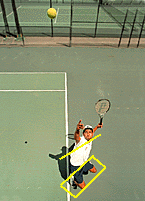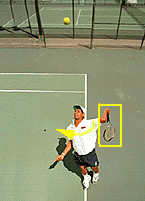|
TennisOne Lessons

Cracking the Serve:
Swing Up for Greater Leverage
By Jim McLennan, Senior TennisONE Editor
The serve is the most exciting stroke in professional tennis. From Michael
Stich's fluid rhythm, Michael Chang's longer racquet and increased ace production,
to Pete Sampras' uncanny ability to come up with consistent big serves in
the final stages of crucial matches, the whole game flows with the serve.
Yet, at the same time the serve is probably the hardest stroke to master.
I believe one the reasons is that the swing is so darn fast. The naked eye
does not really see what happens with the arm and racquet. It is much easier
to study the arm and racquet action of a player's forehand, and therefore
it is that much easier to watch and then learn groundstrokes or volleys.
In this photo sequence below, shot from well above, we capture Monty Basynat,
one of TennisONE's staff pros and editors, at the peak of his toss, right
before he unwinds into his punishing serve. Let's examine some of the fundamentals
of Monty's excellent service motion.
First, notice that Monty has tossed the ball out in front and into the court,
so he can transfer his weight and momentum forward and lean into the serve.
Monty, a left-hander, has lined his body up at a 45 degree angle to the
net (with his hips and shoulders turned away from the net), much like McEnroe
does. Notice too Monty's deep knee, again very much like McEnroe (do you
think he learned something here?). With the knees, hips and shoulders
pointed away from the net, Monty is able to increase the amount
of rotational force into his swing.
The power in the serve starts with the kinetic transfer of power that starts
with an explosive drive of the knees and quads as the player drives
up from the ground. This energy and power is then transferred through
the upper body as it uncoils and finally into the rotating shoulder and
wrist as it snaps (pronates) through the ball. The second photo below demonstrates
this explosive drive off the ground. As Monty explodes into his serve, he
turns his hips and shoulders into the ball, he extends his legs, and he
drops his tossing arm in rhythm with the upward swing of his hitting arm.
Carefully notice the position of his arm and racquet. With the butt
cap pointing to the sky, Monty is in a position to pull the racquet up and
into the ball. We are all familiar with the teaching phrase,
"swing up and out on the serve," but unless the racquet moves
through this exact spot, the up and out swing will be only minimally effective.
Note that this is not the back-scratch position recommended by some when
serving. Think of your service motion as a "swinging drop"
as the racquet is swung through this spot with the intent to get the racquet
to drop as low as possible. To get the knack for this
arm and racquet placement, visualize throwing darts into the ceiling.
From the bottom of the swinging drop of his racquet head, Monty is ready
to rhythmically uncoil his hips, trunk, shoulders, then finally finishing
the serve with a quick extension of the tricep, and then snap the racquet
forward through the ball with an equally quick forearm roll. The result?
Yes, a cracking serve.
 
Go To:
Tennis Lessons Library
|
|
|